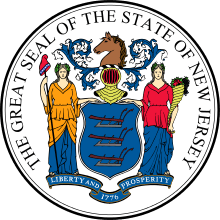Peter Dumont Vroom
| Peter Dumont Vroom | |
|---|---|
 | |
| 9th Governor of New Jersey | |
|
In office November 6, 1829 – October 26, 1832 | |
| Preceded by | Isaac Halstead Williamson |
| Succeeded by | Samuel L. Southard |
|
In office October 25, 1833 – October 28, 1836 | |
| Preceded by | Elias P. Seeley |
| Succeeded by | Philemon Dickerson |
| Member of the U.S. House of Representatives from New Jersey's At-large district | |
|
In office March 4, 1839 – March 3, 1841 | |
| Preceded by | Thomas J. Yorke |
| Succeeded by | Thomas J. Yorke |
| Personal details | |
| Born |
December 12, 1791 Hillsborough Township, New Jersey |
| Died |
November 18, 1873 (aged 81) Trenton, New Jersey |
| Political party | Democratic |
| Religion | Dutch Reformed |
Peter Dumont Vroom (December 12, 1791 – November 18, 1873), an American Democratic Party politician, served as the ninth Governor of New Jersey (serving two terms in office; from 1829–1832 and 1833–1836) and as a member of the United States House of Representatives for a single term, from 1839–1841.
He was born in Hillsborough Township, New Jersey the son of Col. Peter Dumont Vroom (1745-1831) who represented Somerset County as an Assemblyman (1790–91, 1794–96, and 1811–13) and in the Legislative Council from 1798 to 1804 as a Federalist. The younger Vroom graduated from Columbia College, New York in 1808. After studying law at Somerville Academy he was admitted to the bar in 1813.
Vroom was a member of the New Jersey General Assembly from 1826 to 1829. He then served as governor of New Jersey from 1829 to 1832 and 1833 to 1836. As governor, Vroom supported the establishment of the Camden and Amboy Railroad and the Delaware and Raritan Canal.
In 1838, Vroom was one of five Democratic candidates for Congress to become involved in the Broad Seal War controversy. Disputed election results caused the U.S. House of Representatives to challenge the Whig candidates certified by Governor William Pennington. After a lengthy fight, Vroom and the four other Democrats were seated in place of the Whigs. Vroom lost his bid for reelection in 1840.
He then served as a delegate to the New Jersey State Constitutional Convention in 1844. He was appointed by President Franklin Pierce as United States Minister to Prussia from November 4, 1853 through August 10, 1857. He died in Trenton, New Jersey and was buried in the DuMont Cemetery off River Road in Hillsborough, New Jersey.
External links
- Peter Dumont Vroom at the Biographical Directory of the United States Congress
- http://slic.njstatelib.org/slic_files/imported/NJ_Information/Digital_Collections/Governors_of_New_Jersey/GVROO.pdf biography of Governor Vroom at the New Jersey State Library
- Political Graveyard information for Peter Dumont Vroom
| Political offices | ||
|---|---|---|
| Preceded by Isaac Halstead Williamson |
Governor of New Jersey November 6, 1829 – October 26, 1832 |
Succeeded by Samuel L. Southard |
| Preceded by Elias P. Seeley |
Governor of New Jersey October 25, 1833 – October 28, 1836 |
Succeeded by Philemon Dickerson |
| United States House of Representatives | ||
| Preceded by John Bancker Aycrigg, William Halstead, John Patterson Bryan Maxwell, Joseph Fitz Randolph, Charles C. Stratton, Thomas Jones Yorke |
Member of the U.S. House of Representatives from New Jersey's at-large congressional district March 4, 1839 – March 3, 1841 Served alongside: William Raworth Cooper, Philemon Dickerson, Joseph Kille, Joseph Fitz Randolph, Daniel Bailey Ryall |
Succeeded by John Bancker Aycrigg, William Halstead, John Patterson Bryan Maxwell, Joseph Fitz Randolph, Charles C. Stratton, Thomas Jones Yorke |
| Diplomatic posts | ||
| Preceded by Daniel D. Barnard |
United States Envoy to Prussia November 4, 1853 – August 10, 1857 |
Succeeded by Joseph A. Wright |
| |||||||||||||||||||||||||||||||||
|
